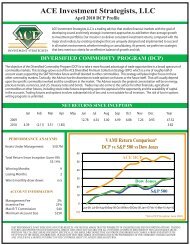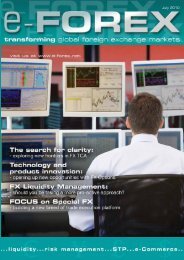Create successful ePaper yourself
Turn your PDF publications into a flip-book with our unique Google optimized e-Paper software.
FEATURES<br />
centre providers such as Equinix are leading suppliers<br />
who provide space, power and connectivity both in and<br />
out of their data centre facilities, as well as among<br />
tenants housed or colocated within their facilities.<br />
Recently, other <strong>com</strong>panies specializing in capital<br />
markets centered proximity services have <strong>com</strong>e to the<br />
market, such as Telx. Similar to Equinix, Telx offers<br />
financial <strong>com</strong>panies and their networks access to a<br />
variety <strong>com</strong>munications and exchange platforms<br />
located within their colocation centres.<br />
Equinix and Telx along with the exchanges and many<br />
other venues, tout their advantages of proximity as it<br />
relates to the lower latency they can provide from a<br />
wide variety of network providers. However, this is<br />
where navigating the mine field could make a<br />
tremendous difference for trading firms of all types.<br />
Going the distance<br />
Proximity to financial exchange platforms is of<br />
ultimate importance when measuring latency in<br />
capital markets. It’s the simple rule of physics that<br />
dictate distance equals latency, and in capital markets<br />
latency equals loss. Eliminating latency is core, so<br />
eliminating distance is the first step. If we took out a<br />
yard stick to measure network latency, no doubt the<br />
shortest path would win and in capital markets, that<br />
could equate to millions of dollars.<br />
For many years, the global tele<strong>com</strong>munications<br />
industry has been measuring its network latency and<br />
selling Service Level Assurances (SLAs) on the<br />
differences based on these numbers. Most networks<br />
measure latency capability based on bandwidth,<br />
which is simply the maximum rate of data that can<br />
flow through a specific media type.<br />
Lighting the Way<br />
Once a path has been determined and latency in<br />
distance agreed upon, the network must be “lit” with<br />
network services. So let’s talk capacity first. Pure<br />
bandwidth is the actual ‘size of the pipe.’ Companies<br />
can simply calculate how many data bytes and<br />
messages can cross a line. The calculations are based<br />
on the size of the market data and order message rates<br />
for example; Nasdaq, NYSE, BATS, Direct Edge and<br />
all the US Equities exchanges in the US are about 1<br />
million messages per second.<br />
If there was no distance from the source to the<br />
consumer server, than a 1 Gig pipe would be 1<br />
microsecond. The more information on the pipe, the<br />
54 | january 2010 e-FOREX<br />
>>><br />
larger the pipe needs to be in order to be as fast. The<br />
further the distance, the larger the “lit” pipe to<br />
ac<strong>com</strong>modate packet and message rates divided by<br />
distance to show the lowest possible latency.<br />
Gearing Up<br />
With microseconds driving all decisions for financial<br />
institutions, choosing which network equipment and<br />
which provider to deploy are often million dollar<br />
decisions. Often, it’s the technology situated in the<br />
various network Points of Presence (PoPs) that can<br />
reduce or increase network latency and more money can<br />
be spent at solving unrelated problems. Equipment,<br />
technology, switches, routers and ensuring redundancy<br />
and security among these key IT network <strong>com</strong>ponents<br />
can be the differentiating factors behind a network’s<br />
viability in supporting proximity trading solutions.<br />
Living in a connected world<br />
Most financial networks require interconnectivity in a<br />
number of locations in order to leverage proximity<br />
trading with the Financial Exchanges. Many of the<br />
key locations are within major cities such as Chicago,<br />
New York, London, Paris and Frankfurt. For<br />
example, the Chi-X Europe Platform connects<br />
<strong>com</strong>panies to multiple financial trading platforms. As<br />
of today, Chi-X has over 100 trading participants<br />
with access to over 1000 of the most liquid stocks,<br />
ETFs and ETCs across 14 European markets.<br />
Companies colocated within close proximity to the<br />
Chi-X have measured a mean latency of 0.4<br />
milliseconds to access other participant networks on<br />
the platform. This type of speed is hard to beat, as<br />
transactions are seemingly <strong>com</strong>pleted in real-time.<br />
Security through diversity<br />
With increased trends toward high frequency and<br />
algorithmic trading, proximity and interconnectivity<br />
to only one trading venue will not provide the<br />
financial gain required to stay ahead. Companies<br />
must connect to multiple financial trading exchanges<br />
in multiple markets – which mean finding a secure<br />
and diverse network provider that can quickly and<br />
efficiently construct and implement custom network<br />
solutions, bringing <strong>com</strong>panies to the ‘safe’ zone in the<br />
mine field.<br />
For example, Hibernia Atlantic is the largest privately<br />
held, US-owned, diverse Transatlantic submarine<br />
provider. Hibernia is dedicated to what it calls<br />
‘Security though Diversity‘ on its network. Realizing<br />
that most networks enter North America and Europe










